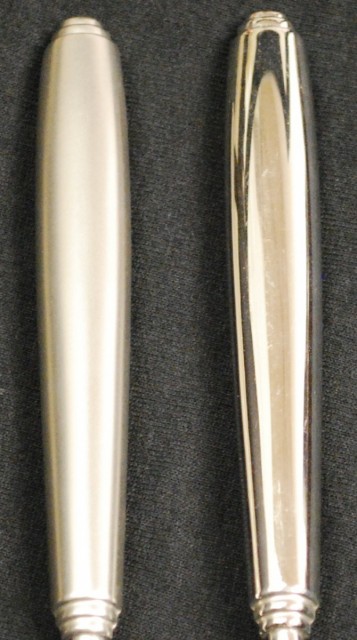Bead blasting is one of the go-to techniques that is most widely used in blasting applications that are mainly focused on improving the appearance of a component. This type of work is often referred to as cosmetic finishing.
Glass bead is the most commonly used media for cosmetic finishing, in fact, many people use the term bead blasting to refer to glass bead blasting, even though a variety of other spherical or bead media are capable of producing a similar type of surface finish.
The Bead Blast Finish
 A beadblast finish has some special characteristics that make it so popular, and one of the most important of these is the reflectivity of a bead blasted metal surface – how it reflects light. When a spherical bead that is harder than the substrate impacts the surface at sufficient velocity, it produces a round-bottomed dimple that behaves likes a tiny concave mirror when light shines on it.
A beadblast finish has some special characteristics that make it so popular, and one of the most important of these is the reflectivity of a bead blasted metal surface – how it reflects light. When a spherical bead that is harder than the substrate impacts the surface at sufficient velocity, it produces a round-bottomed dimple that behaves likes a tiny concave mirror when light shines on it.
A surface covered with thousands of tiny dimples, each reflecting some light, will have a “sheen” or “satin” appearance that can be very attractive. It is not highly reflective and shiny, like a polished surface, because only a little light is reflected directly back at the viewer, but it is bright and semi-reflective, with what some observers consider a “warmer” appearance.
Larger-diameter beads can produce larger dimples, finer bead media make tinier dimples, and blasting parameters such as the distance of the blast gun from the surface, the blast pressure, the angle of the nozzle to the surface and the dwell time (exposure to blast) all have effects on the subtle differences between one bead blasted finish and another. Hold that thought for later discussion.
Bead blasting can blend-in superficial scratches and tool marks to produce an overall sheen finish that enchances and beautifies subsequent processes, such as aluminum or titanium anodizing.
The old saying that beauty is in the eye of the beholder definitely applies to the appearance of metal components and surface finishes. For makers of consumer electronics, sporting goods, firearms, precision instruments, tools and many other types of products. cosmetic finishes are an enormously important competitive concern, because customers will judge the quality of the product, in part, based on finish quality and appearance. Visual appeal and texture or “feel” may be subtle and hard-to-define, but they affect the customer’s reaction to the product and play a major role in pride of ownership.
Four Common Cases
1. You have a brand new product for which you want a knock-their-socks-off appearance that will differentiate it from others in the marketplace. In this case, you may want to compare a variety of alternative finishes and look at the results using less common bead media to produce a distinctive look. Because it is so important to the success of the new launch, you are concerned that the finish decided upon can be produced consistently and at acceptable cost.
2. You have an established product with a known finish that customers expect, but you need more production capacity or more consistent finish quality. In this case, you may plan to use the same bead, or you may consider substitution of another media if it can produce an identical finish, but you are probably focused on automation of the bead blasting process, to improve the uniformity of the finish on all areas of the component and from one production lot to another.
3. A valued customer wants you to start doing bead blast finishing as a condition of extending your contract to reduce the number of suppliers, or the customer wants you to improve the quality of your existing bead blast finishing results. This is another case where the media and the desired finish are knowns, but you are probably looking for the most efficient way to provide the value-added service and produce the beadblast finish at acceptable cost and with acceptable consistency.
4. The bead blast finishing media you currently use, or the process used to produce the finish has undesirable side-effects, such as high cost for consumables or disposal of used media, or it is causing technical problems with a downstream process, such as anodizing or blackening. In this case, you may be looking for a subsitute media or an upgrade of your bead blast finishing equipment.
Alternative Media
If you are generally enthusiastic about the bead blast finish, but you have reason to consider moving away from glass bead blasting, one of the types of blasting materials you may want to consider are some of the microscopic metal shot media, including Guyson Britebead. They are available in exceptionally fine screen sizes, the bead does not fracture in use, they can be used in wheel-blast and air-blast systems, and they are constantly in stock at
Guyson. Visit the media section of our site for more information.
Another engineered blast material may want to evaluate as a substitute or an upgrade from glass bead is ceramic bead. It is available in a wide range of shot sizes, it has good resistance to fracture, it can be used in pressure-blast or suction-blast systems, and it is available from Guyson. Visit the media section of this site for more information.
Replace Manual Bead Blast Processes
Are you still holding that thought from the fifth paragraph?
To reduce or eliminate variation in the technique of bead blasting – the nozzle angle to the surface, the offset or stand-off distance of the nozzle from the surface and the surface speed or dwell time on every square centimeter of every component, you don’t have much choice except to take the the blast nozzle out of human hands. The operators of your manual blast cabinets are adaptive people whose intelligence and talents can be put to productive use elsewhere.
To reduce the inconsistency of your bead blast finishing process, consider the introduction of automated blasting in place of hand blasting. A single automated blast system can out-produce several manual cabinets, lower processing costs and improve your finish quality. Have a look at some of the styles and types of automated bead blast machines here.
To eliminate inconsistency in the beadblast finishing process, even when working with complex-shaped components in a broad range of different sizes, consider the introduction of robotic blasting. Have a look at some robotic machine models here.



